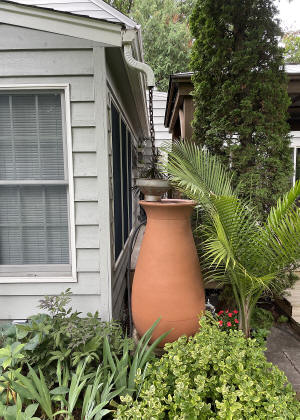|
 Be
a Weather Watching Gardener Be
a Weather Watching Gardener
By Melinda Myers
 Send a link to a friend
Send a link to a friend
[January 18, 2025]
Each gardening season seems to offer new growing
challenges. Our gardens are exposed to more drastic and variable
weather with changing weather patterns. Floods, droughts, wind,
temperature extremes, and unseasonable weather episodes can have
immediate and long-term impacts on our plants.
Monitoring and noting these occurrences will help you diagnose
immediate and future plant and garden problems. It also reminds us
to adjust plant maintenance when these stressors occur and watch for
potential insect, disease, and plant decline that may appear in the
future. |
|
 Create
your own weather station with a rain gauge, snow gauge, and high-low
thermometer. These gauges monitor the conditions in your backyard as
opposed to those reported for nearby locations. Having information
from your yard allows you to make any needed adjustments to watering
and care to help your plants thrive. Create
your own weather station with a rain gauge, snow gauge, and high-low
thermometer. These gauges monitor the conditions in your backyard as
opposed to those reported for nearby locations. Having information
from your yard allows you to make any needed adjustments to watering
and care to help your plants thrive.
Record significant weather extremes that can negatively impact plant
health and longevity. Check with local nature centers, botanical
gardens, and extension services for gardening calendars. Many
include information on significant weather events in your area. You
can then add your observations for future reference. Refer to this
information as needed in the future to help diagnose plant problems
that may result from these extremes.
Large trees and other established plantings are often overlooked
when weather extremes occur. Extended dry periods, temperature
extremes, and flooding can stress and weaken these plants making
them more susceptible to insect pests, diseases, and decline in the
coming years.

Always select plants suited to the growing
conditions and start watching for those that appear to be more
tolerant of extremes. Visit local public gardens and consult with
your University Extension specialists and other plant experts when
selecting new plants for your gardens.
Adapt your landscape maintenance and design to reduce the negative
impact of flooding, drought, and temperature extremes. Protect plant
roots from temperature extremes with a layer of organic mulch.
Incorporate organic matter into the soil to improve drainage and
increase the water-holding ability of fast-draining soils. Cover the
soil with plants and mulch to help protect the soil from compaction
and erosion during heavy downpours. Healthy soil is the key to
growing plants that are better able to tolerate environmental
stresses.
[to top of second column] |

Manage water that falls on your property. Check with
your local municipality for any restrictions or support for these
efforts. Create rain gardens to capture, clean and direct rainfall
to groundwater to help manage water where it falls. These also
support pollinators and provide added beauty to your landscape.
Enlist the help of rain barrels, if permitted, to capture rainwater
to use on ornamental plantings and containers when needed.
Take this interest one step further and volunteer to be part of a
network of volunteer weather watchers. The Community Collaborative
Rain, Hail and Snow Network (CoCoRaHS) is a non-profit
community-based network of volunteers that provides daily
measurements of rain, hail, and snow that fall in their backyards.
The goal of the Network is to provide more localized weather
information to scientists, researchers, resource managers, decision
makers and more. The data is used for natural resource, educational
and research applications.
Weather watching is a great project for the family or classroom. It
helps boost gardening success while increasing our awareness and
knowledge of what’s happening around us.
Melinda Myers has written over 20 gardening books,
including Midwest Gardener’s Handbook, Revised Edition, and Small
Space Gardening. She hosts The Great Courses “How to Grow Anything”
instant video and DVD series and the nationally syndicated Melinda’s
Garden Moment radio program. Myers is a columnist and contributing
editor for Birds & Blooms magazine. Myers’ website is www.MelindaMyers.com.
[Photo courtesy of MelindaMyers.com]

|